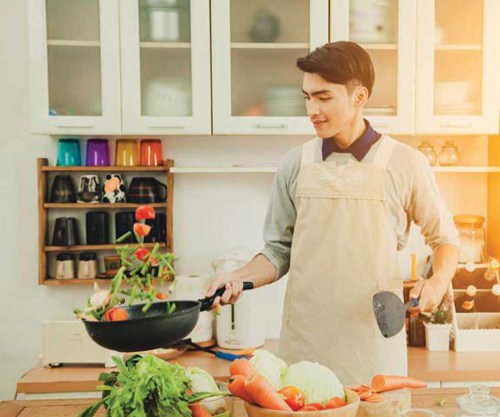Get your teen comfortable cooking in the kitchen
Published 12:00 am Wednesday, April 1, 2020

- Asian young man is cooking
Teaching your child to cook isn’t only so that you can sit back with a glass of wine and be waited on hand and foot. I mean, that’s a benefit, but there’s so much more to it. Teaching kids to cook leads to healthier bodies and budget-conscious adults. It supports brain function, memory, and is a great tool to connect with others and combat the loneliness that may come when it’s time to leave the nest. They save money and can easily impress first dates.
Before your teen actually starts cooking, you will need to teach them some basic kitchen skills. Since we may all be spending a lot of time at home together for a while, there’s no time like the present.
Trending
Teach your child to budget and shop. Give them a set amount of money to purchase everything needed for a meal for your family. They should plan out how much they need and what everything is going to cost. (This part may have to wait until prices and supplies stabilize.)
Teach them what each of the different knives are for and how to use them safely. They’ll need to know how to dice and mince, being sure to hold the food with their fingers back, knuckles closer to the blade. Keep your knives sharp, as dull blades can slip.
They will need to know how to cut meat and vegetables, including onions. Meat should be cut against the grain. Of course, everyone has her own way of chopping onions without burning her eyes.
Teens should know that lack of oxygen can put out a fire. Put the lid on the pot (with a pot holder) and take it off the burner. Close the oven door and turn off the oven. Use a wet towel to cover the flames, but not on a grease fire. Something I learned first-hand is that when cooking with grease (like making fried chicken), keep a container of baking soda or salt nearby. Don’t use flour to put out a grease fire — it can explode. My call to 911 brought some cute firemen, but that didn’t make up for the embarrassment of not being able to put out a tiny kitchen fire.
Speaking of fire, your teen should know basic first aid, understanding how to address cuts and burns. Apply direct pressure to a cut, run a burn under cold water and then loosely bandage it.
Teach your kids the difference between dry measures and wet measures. They should know which tools are used for each. Along these same lines, be sure they know basic measures and conversions, ounces, pounds, cups, tablespoons, etc.
Trending
Teens need to know safe food handling. Wash your hands after touching raw meat, wash fruits and vegetables before you eat them or cook with them.
Have your kids read the recipe twice and then set everything out before they start. Experts suggest having them measure out each ingredient and line it up in the order it will be used. It saves time, provides for fewer mistakes, and gives them the opportunity to ensure that they have all the ingredients.
Finally, and most importantly, teach them to clean. Cleaning as you go saves time and keeps them from being overwhelmed at the end (and likely sneaking out of the house while the kitchen is still a mess). They should know what rags to use, which cleaners, what can and can’t go into the dishwasher, and how to sanitize things that have come into contact with raw meat.
Now that we have that covered, let’s move on to what they should actually know how to cook. Before they move out of your house, a young adult should know how to cook the following:
Eggs (fried and scrambled)
Potatoes (baked and mashed)
Pasta (with sauces — red, meat, and white)
Meat (chicken, turkey, ground beef, pork, bacon, sausage)
Stir fry (diced meat, lots of healthy veggies)
Salad (it’s not just a vehicle for dressing)
Something sweet (brownies or cookies)
With a little luck, some patience, and a healthy dose of salt and pepper, your teen will be cooking delicious meals in no time.
________
Suzanne Kennedy is a former middle school teacher who lives in Pendleton with her husband and four children.









